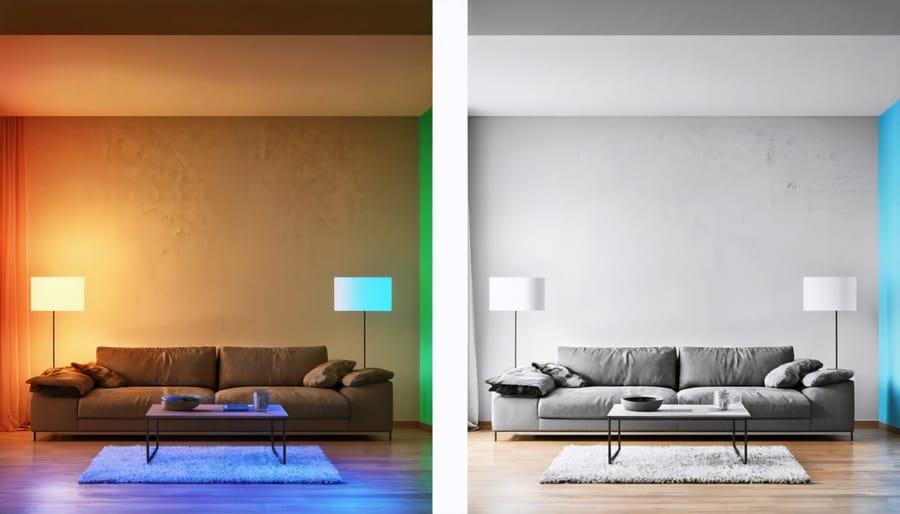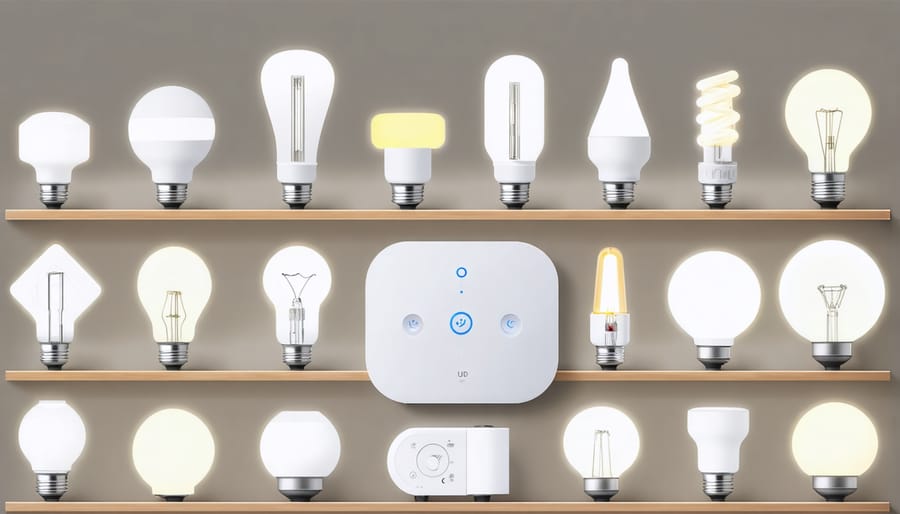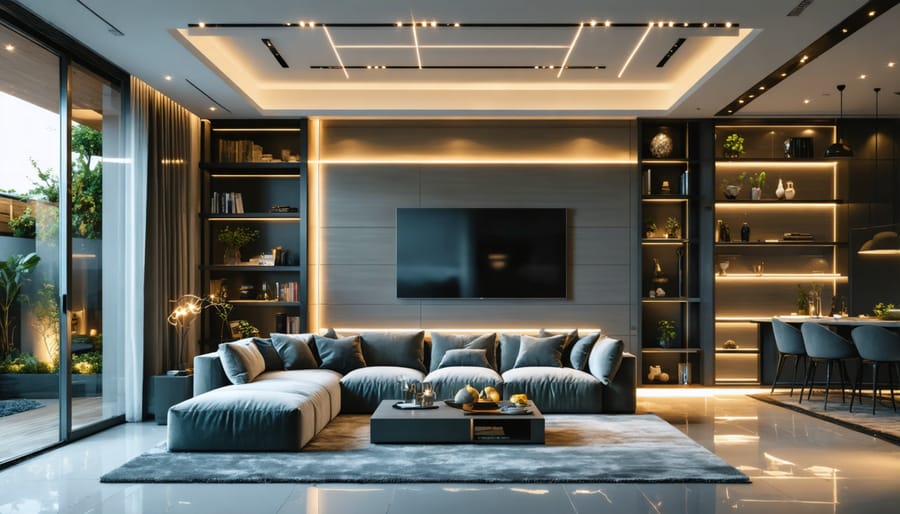Transform any living space instantly with smart ambient lighting that responds to your daily rhythms, mood, and activities. Modern LED technology lets you transform your room’s ambiance from energizing daylight to cozy evening warmth with a single tap. Beyond simple dimming, today’s smart lighting systems integrate with home automation, adjust based on natural light levels, and create personalized scenes for every occasion – from productive work sessions to intimate dinner gatherings.
Experience the perfect blend of function and atmosphere as smart ambient lights automatically adapt throughout your day, enhancing both the aesthetic appeal and practical functionality of your space. Whether you’re a tech enthusiast or simply looking to upgrade your home’s lighting, smart ambient solutions offer intuitive control, energy efficiency, and unprecedented customization options that traditional lighting simply can’t match.
How Smart Ambient Lighting Shapes Space Perception
The Science of Light and Space
Light has a remarkable ability to transform our perception of space, working its magic through both physics and psychology. When light bounces off walls and surfaces, it creates depth and dimension that can make a room feel larger or more intimate. Warmer lights (2700-3000K) tend to make spaces feel cozy and welcoming, perfect for living rooms and bedrooms, while cooler lights (4000-5000K) can make rooms appear more spacious and energizing.
The direction of light plays a crucial role too. Upward-facing lights create an illusion of higher ceilings by drawing the eye upward, while wall-washing techniques can make rooms feel wider. Strategic placement of light sources at different heights adds layers to your space, creating visual interest and depth.
Color temperature isn’t just about aesthetics – it affects how we perceive textures and colors in our environment. Natural daylight (around 5600K) shows colors most accurately, while warm lighting can enhance wood tones and make skin tones appear more flattering. By understanding these principles, you can use smart lighting to completely transform how your space feels throughout the day.
Color Temperature and Mood
The temperature of your lighting plays a crucial role in setting the right atmosphere and can significantly impact your mood and well-being. Just as color psychology in design affects our emotions, different light temperatures create distinct feelings in your space.
Warm white light (2700-3000K) creates a cozy, intimate atmosphere perfect for living rooms and bedrooms. This golden-tinged illumination helps you wind down in the evening and promotes relaxation. It’s ideal for creating that welcoming ambiance during dinner parties or quiet nights in.
Cool white light (4000-5000K), on the other hand, mimics natural daylight and helps boost energy and focus. This makes it perfect for home offices, kitchens, or craft rooms where task lighting is essential. Many smart ambient lights allow you to transition between these temperatures throughout the day, following your natural circadian rhythm.
The beauty of smart lighting is that you can easily adjust the color temperature to match your activity or mood. Whether you’re working, entertaining, or getting ready for bed, the right light temperature can enhance your space and support your daily routine.

Smart Ambient Lighting Technologies
Smart Bulbs and LED Strips
Smart bulbs and LED strips are the workhorses of modern ambient lighting, offering endless possibilities for transforming your space. Popular smart bulbs like Philips Hue, LIFX, and Nanoleaf provide full-spectrum RGB color control, allowing you to shift from energizing daylight whites to cozy warm tones with just a tap on your smartphone.
These bulbs easily retrofit into existing fixtures and typically offer 16 million colors plus tunable whites ranging from 2700K to 6500K. Most smart bulbs connect via WiFi or Bluetooth, though some use dedicated hubs for more reliable control and advanced features like music synchronization and automated schedules.
LED strips have become a favorite for creative ambient lighting solutions. They’re perfect for indirect lighting under cabinets, behind TVs, or along crown molding. Many models, like the Philips Hue Lightstrip Plus or Govee LED strips, can display multiple colors simultaneously and respond to music or on-screen content.
Key features to look for include:
– Voice control compatibility with Alexa or Google Assistant
– Scheduling and automation options
– Color zones (especially for LED strips)
– Brightness levels and color accuracy
– App interface quality and reliability
– Integration with other smart home devices
When choosing between options, consider the ecosystem you’re already using and your specific lighting needs. While premium brands offer better color accuracy and reliability, budget-friendly alternatives can still provide impressive results for basic ambient lighting needs.

Control Systems and Integration
Modern smart ambient lighting systems have revolutionized how we control and interact with our home lighting. Through smart home integration, you can easily manage your ambient lighting using smartphone apps, voice commands, or automated schedules.
These systems typically consist of three main components: smart bulbs or LED strips, a central hub or bridge, and a user interface. The hub acts as the brain of your lighting system, communicating with individual lights and your home network. Popular platforms like Phillips Hue, LIFX, and Nanoleaf offer user-friendly apps that let you create custom scenes, set schedules, and adjust brightness and color temperature with just a few taps.
What makes these systems truly “smart” is their ability to work with other home automation devices. You can sync your lights with motion sensors, smart thermostats, and even your TV for an immersive entertainment experience. Many systems also support voice control through Amazon Alexa, Google Assistant, or Apple HomeKit, making it incredibly convenient to adjust your lighting hands-free.
For those just starting out, most manufacturers offer starter kits that include everything you need to begin. As your needs grow, you can easily expand your system by adding more bulbs or accessories. The best part? Many of these systems can be installed without any special wiring or technical expertise – perfect for renters and homeowners alike.
Practical Applications in Different Rooms
Living Spaces
Living rooms and family areas are the heart of our homes, making them perfect spaces to showcase the transformative power of smart ambient lighting. Start by layering your lighting with a combination of ceiling-mounted smart fixtures for general illumination and smart LED strips along architectural features or behind entertainment centers for depth. Consider placing smart table lamps in corners or near seating areas to create cozy conversation zones.
For movie nights and entertainment, program scenes that automatically dim overhead lights while activating subtle wall washing effects. This creates the perfect atmosphere without harsh glare on screens. During daytime, use tunable white lights to complement natural light, gradually transitioning to warmer tones as evening approaches.
Smart motion sensors can be particularly useful in living spaces, automatically adjusting brightness levels as family members move between areas. For open-plan layouts, use different lighting zones to define distinct areas while maintaining visual harmony. Create preset scenes for various activities – “Reading” with focused task lighting, “Entertainment” with ambient backlighting, or “Relaxation” with soft, warm illumination.
Don’t forget about color possibilities – while subtle is often better for living spaces, occasional pops of color can enhance special occasions or holiday celebrations. Install light strips behind crown molding or under floating shelves to add sophisticated architectural lighting that transforms your space from ordinary to extraordinary.

Bedrooms and Relaxation Areas
Your bedroom should be a sanctuary of peace and relaxation, and smart ambient lighting plays a crucial role in helping you create a cozy atmosphere perfect for unwinding. Start by installing color-changing smart bulbs in your bedside lamps, which can transition from energizing bright whites during the day to warm, soft yellows in the evening.
Consider adding LED strip lights behind your headboard or under the bed frame for a subtle, floating effect that adds depth to the room without being overwhelming. These can be programmed to gradually dim as bedtime approaches, naturally signaling your body that it’s time to wind down.
For maximum relaxation, set up automated evening routines that sync your lights with your preferred bedtime. Your smart lighting system can gradually decrease brightness over 30 minutes, mimicking a natural sunset. This helps regulate your circadian rhythm and promotes better sleep quality.
Don’t forget about reading nooks and meditation corners. Install adjustable smart spotlights that can be brightened for reading but dimmed for meditation sessions. Add motion sensors in hallways leading to the bathroom for gentle nighttime illumination that won’t disturb your sleep cycle.
Remember to choose bulbs with good color rendering indexes (CRI) to ensure your bedroom’s colors appear natural and soothing, regardless of the lighting scene you’ve selected.
Kitchen and Work Areas
In kitchens and work areas, smart ambient lighting isn’t just about creating atmosphere – it’s about enhancing functionality and safety. Under-cabinet lighting strips can illuminate countertops for food preparation, while adjustable overhead lights ensure you can clearly see what you’re cooking. The key is to layer your lighting strategically.
Consider installing motion sensors that automatically brighten the space when you enter, particularly useful when your hands are full of groceries. Color-temperature adjustable bulbs are especially valuable here – use cooler, brighter whites (5000-6500K) during meal prep and cleaning, then switch to warmer tones (2700-3000K) for casual dining or entertaining.
Task-specific zones deserve special attention. Install focused lighting above the sink, stove, and prep areas. Smart switches can create preset scenes – “Cooking” mode might activate all task lights at full brightness, while “Clean-up” could focus on sink and counter areas.
For home offices and craft spaces, combine overhead ambient lighting with adjustable desk lamps. Program your lights to gradually brighten in the morning, mimicking natural daylight to help maintain your circadian rhythm. Consider adding light strips behind monitors to reduce eye strain during long work sessions.
Remember to position lights to minimize shadows on work surfaces, and include dimming capabilities for different times of day and tasks. The goal is to create a flexible lighting system that adapts to your activities while maintaining energy efficiency.
Setup and Programming Tips
Basic Installation Steps
Setting up your smart ambient lighting system is easier than you might think. Start by choosing a central location for your smart hub or bridge, ideally near your Wi-Fi router for optimal connectivity. Next, download the manufacturer’s app to your smartphone – this will be your control center for managing your lights.
Begin with one room to get comfortable with the system. Install your smart bulbs by simply screwing them into existing fixtures, or mount your LED strips in your chosen locations. Most strips come with adhesive backing – just clean the surface thoroughly before application.
Power up your lights and open the app to begin the pairing process. Follow the in-app prompts to connect each light to your system. This usually involves pressing a sync button or power cycling the lights. Once connected, you can name each light based on its location for easier control.
Test your setup by trying basic commands like dimming or changing colors. If you’re using a voice assistant, enable the lighting skill in your assistant’s app and try a few voice commands. Remember to create a few basic scenes for different times of day – this will help you get the most out of your new setup right away.
Creating Custom Scenes
Creating personalized lighting scenes is easier than you might think, and it’s a fantastic way to transform your space for different activities and moods. Start by considering the main activities that happen in each room. For your living room, you might want a “Movie Night” scene with dimmed lights and subtle accent lighting, or a “Party Mode” with vibrant, dynamic colors.
Programming these scenes is usually done through your smart lighting app. Begin by adjusting individual lights to your desired brightness and color temperature. For example, set overhead lights to 30% brightness with warm white for a cozy evening scene, or boost them to 100% with cool white for productive work sessions.
Don’t forget to consider natural light when creating your scenes. Program “Good Morning” scenes to gradually brighten rooms at sunrise, or set “Sunset” scenes to automatically adjust as daylight fades. For special occasions, try combining different light colors – warm whites with subtle amber accents create an inviting dinner party atmosphere.
Remember to save your favorite combinations and give them memorable names. Most smart lighting systems allow you to activate scenes with voice commands or scheduled timers, making it even more convenient to switch between your custom lighting moods.
Smart ambient lighting represents a remarkable fusion of technology and interior design that can truly transform your living space. By implementing these intelligent lighting solutions, you can create environments that adapt to your needs, enhance your mood, and complement your daily activities.
The benefits of smart ambient lighting extend far beyond mere convenience. From improving your sleep patterns with automated color temperature adjustments to creating the perfect atmosphere for entertaining guests, these systems offer unparalleled versatility. They can help reduce energy consumption through motion sensors and scheduling, potentially leading to significant savings on your electricity bills.
When choosing a smart lighting system, consider starting with a basic setup in high-traffic areas like your living room or kitchen. As you become more comfortable with the technology, you can gradually expand to other spaces. Look for systems that offer compatibility with your existing smart home devices and provide user-friendly controls through mobile apps or voice commands.
Remember that successful implementation doesn’t require a complete overhaul of your current lighting setup. Start small, experiment with different settings, and customize the system to match your lifestyle. Whether you’re a tech enthusiast or simply looking to enhance your home’s ambiance, smart ambient lighting offers a practical and stylish solution that can elevate your living space while providing tangible benefits for years to come.
